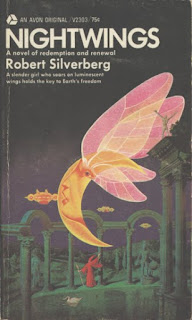© 1968 by Robert Silverberg
Winner, 1969 Hugo Award for Best Novella
The time: Late “Third Cycle,” several centuries –
possibly millennia – in the future.
The place: Earth, long suffering through several
cataclysmic surface-changing events from directed climatic alteration gone
wrong. Specifically, three cities, Roum, Perris, and Jorslam.
The background: A broken, lost society, longing for
the glories of the Second Cycle, held together with the glue of the guilds:
dozens if not hundreds of fellowships giving meaning to the fleeting existences
of the masses. All is guild, from Dominators to Servitors, Rememberers to
Watchers, Fliers to Changelings to Neuters, Vendors to Transporters to Clowns.
Our hero is a nameless Watcher, tasked to scan the
skies via some strange sort of astral projection, thrice daily week after month
after year, alert for alien invasion. Though Earth is sort of a low-budget
tourist stop for alien life, Watchers stand lonely on the lookout for an
ancient prophesied attack. We catch up to the Watcher midstream nearing the end
of his life, en route across the Land
Bridge from Agupt to Talya, specifically the once-yet-still-grand city of Roum.
Accompanying him are two others, the blithe
fairy-human Flier, Avluela, and the cagey shape-shifting Changeling Gormon. Old
Watcher is in love – mostly in a paternal way – with Avluela, and bone-wary of
Gormon. Still, on a world of nomads such as Third Cycle Earth, it is more
dangerous to travel companionless than companioned, so the trio together enter
the great golden city.
Then, all hell breaks loose.
How to convey a wonderful tale without spoilers, since
I know not whether you will ever read this book? Like all Silverberg to me, I
could not put it down, for who could set aside a story with seemingly a
surprise – a legitimate, unforeseen surprise you realize you should’ve seen
coming – in every chapter? The tale turns twists a lesser author would botch;
several times over the three nonstop days I journeyed with these characters I
had to pause in wonder at their fates, bidden and unbidden, and equally their
resolutions.
If this sounds oblique, I am intending it to be so. If
you are a science fiction aficionado and have not read this book, do so. A
master class in storycraft. Normally in my “reviews” I drop some pretty hefty
hints of what you’ll come across; heck, just read my review of Silverberg’s Downward to the Earth a week back for a
sampling. But I do not think that appropriate for Nightwings …
But I will say, should you open these pages, you’ll
find –
Not one but two infidelities, both ending badly
First-person noncombatants in the fog of blitzkrieg
Ethereal bodies soaring in the twilit skies
A lamplike squidlike alien decapitation
50th-century optical prosthetics
Overbearing princes, oily merchants, poetic overlords
Fortune-tellers who foretell the present
Starstones to decipher the will of the Will
And man with his back against the wall who sells out
mankind
But, glorious of all, redemption. Redemption for both the Watcher and the planet. For,
like Downward to the Earth, there is
re-birth in this world, too, with similar concomitant risks and rewards.
Although in Nightwings the redemption
is more transcendent, more transformative, more organic and more world-wide. It’s
rebirth for not only the Watcher (who, in fact, changes guilds not once, not
twice, but three times – possibly four – over the course of the novel) but
simultaneously the World itself, mankind, in all its genetic variations,
itself. The whole thing teetered toward hippie kumbaya for a sentence or two,
and I got nervous, but it rightly righted itself and ended with an ending only
slightly less shiver-bump inducing than Downward.
Grade: A+
Note: In hindsight, I learned that Nightwings was actually three novellas published
in the pulps and patched together into a single work in 1968. The whole thing
works seamlessly. It’s divided into three parts, for each geographic city where
the action occurs: Roum, Perris, and Jorslam, where the rebirth takes place. It
won the 1969 Hugo Award, was nominated for a Nebula Award, and won the Prix
Apollo Award – for best SF novel published in France – in 1976.

No comments:
Post a Comment